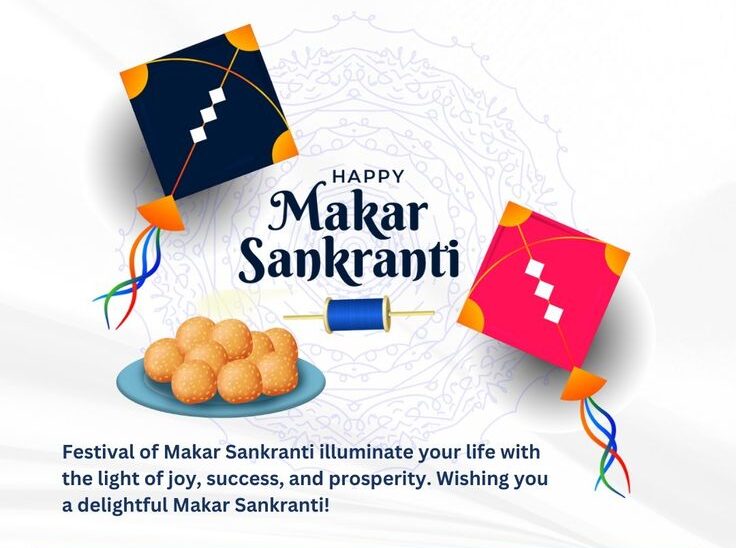🪁 Introduction: Celebrating the Sun’s Divine Transition
Makar Sankranti is one of the most significant and widely celebrated Hindu festivals across India, known for its spiritual positivity, seasonal significance, and social harmony. Observed every year on January 14th or 15th, it marks the Sun’s transition into the zodiac sign of Capricorn (Makar) and the beginning of longer, warmer days—an auspicious astronomical event.
- 📜 History of Makar Sankranti
- 📅 Timeline of Makar Sankranti
- 🧠 Key Facts About Makar Sankranti
- ❓ Frequently Asked Questions (FAQs)
- 1. What is the spiritual meaning of Makar Sankranti?
- 2. Why do people fly kites on Makar Sankranti?
- 3. What foods are eaten during the festival?
- 4. Is there any specific river ritual?
- 5. Why is this festival celebrated differently in every region?
- 📌 Significance of Makar Sankranti
- 🌞 1. Astronomical Significance
- 🙏 2. Religious Significance
- 🌾 3. Agricultural Significance
- 🤝 4. Social and Cultural Harmony
- 🎉 Regional Observance Across India
- 💬 Popular Wishes & Messages for Makar Sankranti
- 🧩 Important Points to Remember
- 🌱 Importance in Our Daily Lives
- 🤝 Importance in Society
- 🧘♀️ Conclusion: Soaring High in Values & Vision
From kite flying in Gujarat, Khichdi feasts in Uttar Pradesh, Pongal in Tamil Nadu, to Lohri in Punjab, Makar Sankranti takes diverse cultural forms, yet all unite to celebrate nature, harvest, and renewal.
Let’s explore the history, facts, timeline, observances, impact, and societal importance of this beautiful day that fills the sky and hearts with brightness.
📜 History of Makar Sankranti
Makar Sankranti is one of the few Hindu festivals based on the solar calendar rather than the lunar one. Its origins can be traced back to ancient Vedic times, when the movement of the Sun was closely observed and celebrated.
According to the Puranas, on this day, Surya Dev (Sun God) visits the house of his son Shani (Saturn), and despite their differences, it symbolizes the importance of familial bonding.
It is also believed that Bhishma Pitamah chose to leave his mortal body on this day during the Mahabharata era, signifying Moksha (liberation).
📅 Timeline of Makar Sankranti
| Year/Period | Event Description |
|---|---|
| Ancient Vedic Era | Makar Sankranti referenced in scriptures and Vedas |
| ~3000 BCE | Agricultural celebrations begin during winter solstice |
| 1000 BCE – 500 CE | Mentions in Mahabharata & Puranas about Bhishma’s death on this day |
| 2001 CE | First International Kite Festival held in Gujarat |
| Present | Celebrated in 30+ cultural variants across India and Nepal |
🧠 Key Facts About Makar Sankranti
🌞 It marks the Sun’s transition from Sagittarius to Capricorn (Makar).
📅 It usually falls on January 14th, but occasionally on the 15th.
🪁 Known for kite flying festivals, especially in Gujarat and Maharashtra.
🍚 Special dishes include Tilgul (sesame jaggery sweets), Khichdi, and Pongal.
📿 It’s a day considered highly auspicious for donations, spiritual practices, and bathing in holy rivers.
🌾 It celebrates the end of winter and the beginning of the harvest season.
🌍 Similar solar festivals are celebrated globally—like Maghi in Punjab, Thai Pongal in Tamil Nadu, and Maghe Sankranti in Nepal.
❓ Frequently Asked Questions (FAQs)
1. What is the spiritual meaning of Makar Sankranti?
It signifies the victory of light over darkness, the end of inauspicious days, and the beginning of Uttarayana, the Sun’s northward journey—symbolizing enlightenment and hope.
2. Why do people fly kites on Makar Sankranti?
Flying kites in the sunlight boosts Vitamin D in winter and is also a symbol of freedom and joy.
3. What foods are eaten during the festival?
Tilgul (sesame & jaggery sweets)
Khichdi
Ladoos made of peanuts and sesame
Pongal (sweet rice) in Tamil Nadu
4. Is there any specific river ritual?
Yes. Taking a holy dip in rivers like the Ganga, Yamuna, and Godavari is believed to cleanse sins.
5. Why is this festival celebrated differently in every region?
Because India is culturally diverse, Makar Sankranti adapts to local traditions, cuisines, languages, and climatic conditions.
📌 Significance of Makar Sankranti
🌞 1. Astronomical Significance
It marks the Sun entering Capricorn, initiating longer, warmer days, and is scientifically aligned with the winter solstice cycle.
🙏 2. Religious Significance
Believers take holy baths, offer food to ancestors, and seek blessings for health, wealth, and spiritual progress.
🌾 3. Agricultural Significance
Farmers celebrate the ripening of crops and express gratitude to nature and deities for a good harvest.
🤝 4. Social and Cultural Harmony
It brings people from different backgrounds together, fostering unity and happiness.
🎉 Regional Observance Across India
| Region | Local Name | Special Traditions |
|---|---|---|
| Gujarat | Uttarayan | Kite flying and Undhiyu |
| Punjab | Maghi | Bonfires and eating ‘Rauh di Kheer’ |
| Tamil Nadu | Thai Pongal | Cooking Pongal and worshipping Surya |
| Maharashtra | Makar Sankranti | Exchange of “Tilgul” with the phrase “Tilgul ghya, god god bola” |
| Bihar & UP | Khichdi Parv | Bathing in Ganga and eating Khichdi |
| Bengal | Poush Sankranti | Ganga Sagar Mela and sweets |
| Assam | Magh Bihu | Community feasts and traditional games |
💬 Popular Wishes & Messages for Makar Sankranti
🪁 “Wishing you skies full of kites and hearts full of joy. Happy Makar Sankranti!”
🌞 “May the warmth of the rising sun fill your life with happiness and success.”
🍚 “Let the til and gud of Sankranti add sweetness to your life.”
🧡 “This Sankranti, may you soar high just like your kites. Stay blessed.”
🧩 Important Points to Remember
Offer prayers to Sun God in the early morning.
Avoid arguing or speaking ill on this auspicious day.
Distribute tilgul and clothes to the needy—charity is highly recommended.
Consume sattvic (pure) food, like Khichdi and sesame sweets.
Kite flying safety is important—use eco-friendly threads.
🌱 Importance in Our Daily Lives
🧠 Mental Well-being
Makar Sankranti promotes gratitude, optimism, and letting go of negativity—boosting emotional health.
🧒 Child Learning
Kids learn traditions, astronomy, teamwork, and community bonding through cultural activities and storytelling.
🧘♂️ Physical Benefits
The Sun exposure during kite flying enhances Vitamin D absorption—especially vital in winters.
🤲 Social Awareness
The day reminds us to give back to society through donations, feeding the poor, and spreading kindness.
🤝 Importance in Society
Strengthens cultural roots in youth.
Enhances rural unity and community spirit.
Provides economic support to artisans, kite makers, and sweet sellers.
Builds social bridges through communal meals and celebrations.
🧘♀️ Conclusion: Soaring High in Values & Vision
Makar Sankranti is not just about kites and sweets—it’s about renewal, gratitude, harmony, and spiritual elevation. As the Sun rises toward the north, so must we rise in our inner light, positive energy, and human connection.
May we embrace this festival with open hearts, open skies, and a promise to live in harmony with nature and each other.
Let your kite carry away your past, and let your heart be open to everything new and bright that’s coming your way!








